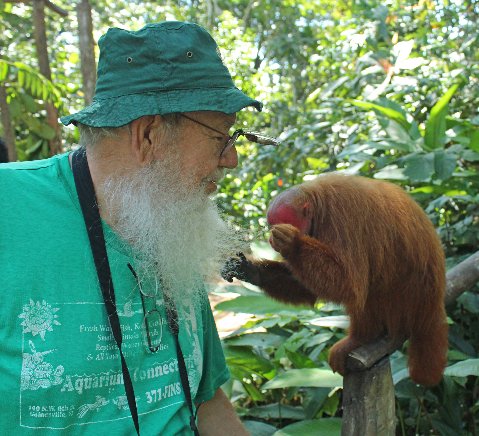We were a couple of nights into our Peruvian Amazon tour and the group, 10 field-herpers including me, had decided that this would be a good night to try to see a caiman or two.

We all piled excitedly into the Amazon equivalent of a John-boat and were, with our Peruvian guide, motoring slowly into a quiet oxbow that was outlined with overhanging shrubs and had great patches of emergent vegetation protruding from the shallows. Flashlight beams probed the darkness, each hoping that it would be their beam that found the reflective eyes of the caiman and each wondering whether it would be a "caiman blanco" (the local name for the spectacled caiman,
Caiman crocodilus) or the more uncommon "caiman negro" (the black caiman,
Melanosuchus niger) that would be the first to be found.
We didn't have to wait long to find out. The boat edged carefully around a fallen tree and ahead was eyeshine. The lights of all but the guide in the prow were turned out (this prevented the guide from being silhouetted and easily seen by the caiman).
Slowly, slowly, the boat edged forward and the prowman whispered "blanco." We were approaching a spectacled caiman. A quick grab by the prowman and the 24 inch long caiman, a lifer for many of the tour participant, was passed back for us all to see.
But there was an extra added attraction here because it quickly became apparent that the surprised (but unharmed) caiman had a half-swallowed something in its mouth. And after a couple of convulsive hiccups by the caiman the something disgorged proved to be a 15 inch long snake--a beautiful snake bearing narrow rings of black, red, and white. A coral snake? No. A coral mud snake,
Hydrops martii, a second and very unexpected lifer found in a most unorthodox manner!
More photos below ...
Temporarily quiet and subdued, this little spectacled caiman surprised us a few moment later.

After a few convulsive wriggles (hiccups) this coral mud snake was disgorged by the spectacled caiman.

 Author, photographer, and columnist Richard Bartlett is one of the most prolific writers on herpetological subjects in the 20th century. With hundreds of books and articles to their credit, Richard and his wife Pat have spent over four decades documenting reptiles both in the field and in captivity. For a list of their current titles, please visit their page in our bookstore. Author, photographer, and columnist Richard Bartlett is one of the most prolific writers on herpetological subjects in the 20th century. With hundreds of books and articles to their credit, Richard and his wife Pat have spent over four decades documenting reptiles both in the field and in captivity. For a list of their current titles, please visit their page in our bookstore. |



To prevent automated Bots from commentspamming, please enter the string you see in the image below in the appropriate input box. Your comment will only be submitted if the strings match. Please ensure that your browser supports and accepts cookies, or your comment cannot be verified correctly.